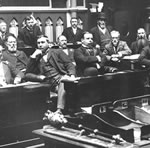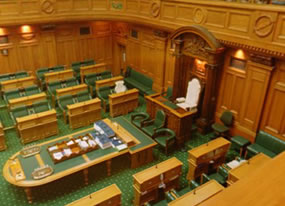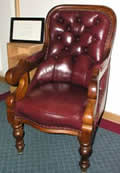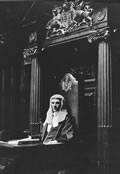A Workplace
Many people call Parliament their workplace, but for MPs and others, the parliamentary complex has not always been the ideal place to spend long hours. The refurbishment of Parliament House and the Parliamentary Library in the 1990s (and the Beehive from the early 2000s) changed that, but for a good part of Parliament's history, the buildings, and the chamber especially, could be uncomfortable.
In the chamber
Early Parliaments had been cramped affairs, with members sometimes squashed into spaces too small and that were either too hot, too cold or too draughty. The Auckland chamber was hot and stuffy, but as soon as the windows were thrown open, MPs complained that the draught set off their rheumatism.
Wellington was not much better. The drainage around the buildings was poor, and the politicians complained of bad smells wafting into the chamber, including from the Bellamy's kitchen. The smell of 'burnt bones, onions, and kindred compounds' was 'simply detestable', one MP claimed.
In the 1870s the chamber was enlarged and new seating installed ― double padded leather couches set out in a horseshoe formation, with the government on the right of the Speaker, and the Opposition on the left (in a colder, more draughty area). The place was lit by 240 gaslights, which certainly provided light, but made the chamber hot and airless. The drains smelled so bad that an MP suggested the local council sprinkle eau de Cologne about the local streets. Despite the installation of fans, air purifiers and vents, as well as the shift into the new chamber from 1918, things did not improve until the later 1940s.
Hear MPs John A. Lee and Keith Holyoake discuss working in the House (1mb, mp3). See a transcript and more information for this recording.
The Speaker's Chairs
The Speaker's chair and dais today. The seating arrangement in the chamber is still basically the same as that set out in 1870s. View as panorama.
The Speaker's chair on the dais at the head of the chamber is part of the Speaker's authority over the House. There have been several different chairs throughout Parliament's history. The first chair, used by Speaker Charles Clifford, was nothing more than an ordinary padded armchair; when Parliament moved to Wellington in 1865, this chair stayed in Auckland. In 1955 it returned to Parliament on loan as an historic item.
There was new furniture when MPs moved into the new Parliament House in 1918, including a plain chair for the Speaker, Frederic Lang. His successor, Charles Statham, preferred to see more tradition and dignity in the House, so he had a special chair made. Designed and manufactured by a Dunedin furniture specialist (and costing £71 to make, a very large sum at the time), this was a high-backed leather 'Empire Chair' with the New Zealand coat of arms at its head. Labour Speakers in the 1930s refused to use it and it was banished to the basement, and then in 1947 given to Statham's widow. It was returned to Parliament in 2001.
The current chair dates back to 1951. It is made of English oak with a carved headboard, upholstered in green hide, and with New Zealand 's coat of arms at its head. It was a gift from a visiting British parliamentary delegation to recognise 100 years since the passage of the 1852 New Zealand Constitution Act.
Next: The Library >



